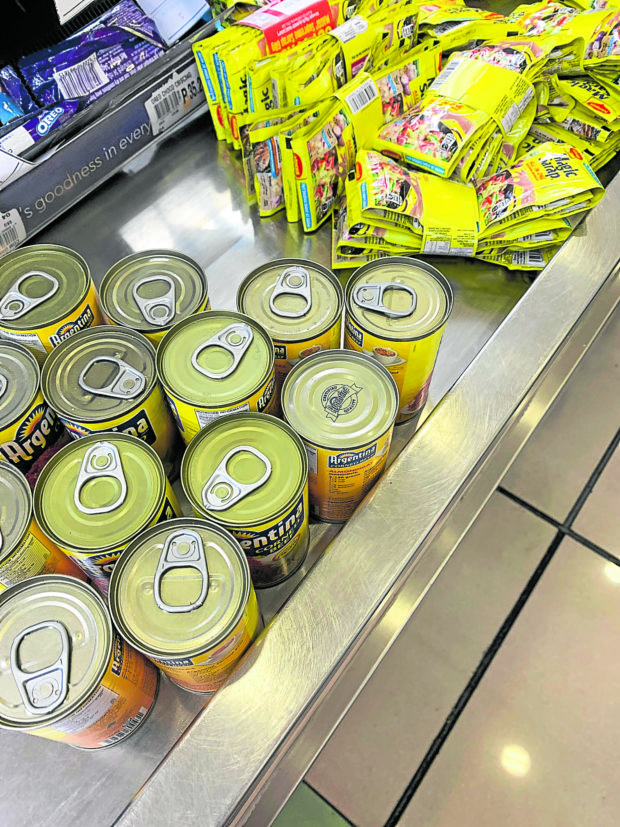When I first saw Ana Patricia Non’s community pantry in Maginhawa, like so many others, I thought, “Hey, maybe I could put up a pantry in my neighborhood.”
But this idea was quickly shot down by my mother and brother, who expressed their concerns about me potentially exposing my grandparents, who lived just a few steps away from us, to the coronavirus.
I didn’t argue with them anymore. If I couldn’t put up my own community pantry, I figured that I’d just help those who did. There are so many ways to help the movement.
I joined the Community Pantry PH group on Facebook to see what the pantries needed. The group is a mix of organizers, donors and community pantry advocates and offers a wealth of information for those who want to help. I took note of what the pantries usually offered—rice, canned goods, vegetables, condiments, coffee, eggs, noodles—and made a grocery list.
When a friend in the United States found out I was in the supermarket buying supplies for pantries, she quickly sent money but she had a very specific request: She wanted me to buy biscuits or snacks. Eventually, she decided that I should use her money to buy cheese cupcakes, a lot of cheese cupcakes.
I filled the carts with noodles, sardines, corned beef, meat loaf and other canned goods, coffee, detergent and loaves of bread. I also added a lot of Magic Sarap because I figured that the families would need seasoning for the many vegetables that people were donating.
At home, we repacked the goods into boxes, to make sure each pantry would get a mix of everything.
First stop
Soon, our community pantry caravan was on its way, car crammed full of boxes and armed with the online map of pantries (saanyan.github.io/saanmaycommunitypantry) created by geographers from the University of the Philippines including Andi Tabinas, Carlo Felipe, Christie Garcia, David Garcia, Ian Lopez, Mikko Tamura, Ony Martinez and Roel Parangat Jr.

Our first stop was the ICM District House on Banawe Street, Quezon City, behind my alma mater, St. Theresa’s College. The Missionary Sisters of the Immaculate Heart of Mary had put up a pantry there.
Because it was already afternoon, the table being used as the pantry was bare. Above it were signs with the already familiar words: “Kumuha ayon sa pangangailangan” and “Magbigay batay sa kakayahan.”
Another sign read: “Mag-
alcohol muna bago kumuha. Please observe social distancing.”
A security guard welcomed me into the compound, allowing me to place the boxes along with others already waiting for the next day’s pantry.
“Theresian po kayo, ma’am?” he asked, telling me that most of the donors who had been stopping by to bring goods were STC alumnae.
He said the pantry opens very early each morning. As I was leaving, another woman was getting out of her car with boxes of donations. We nodded at each other and smiled from behind our masks and face shields.
Using the “Saan May Community Pantry?” map as our guide, we headed to our next destination: the Missionary Sisters of Sacro Costato Community Pantry at 13 Scout Magbanua St., Quezon City.
Drop-off
There, two red and black metal shelves were being used for the goods. A sign hung from it: “Scout Magbanua/Mother Ignacia Community Pantry Project (Inspired by Ana Patricia Non’s Maginhawa Community Pantry Project).”
A nun wearing a habit welcomed us. My mother greeted her cheerfully from inside the car (she wasn’t allowed to go down). Drop-off was quick, less than a minute.
Some drop-off points were easier to find than others. But finding a pantry to help was never a problem—there was always one nearby.
At the Scout Dr. Lazcano Community Pantry, the sign had an English translation: “Give what you can. Take what you need.” And below it, words that pinched my heart: “Food is a basic human right.”
We waved goodbye to the organizers as we started to drive off. One of them clasped her hands together and pressed them against her chest, nodding in thanks.
(This, by the way, was the pantry forced to close by their barangay because they wanted to consolidate the pantries in the area. The local government intervened and organizer Ina De Dios has reopened it in Tomas Morato. They continue to serve 300 to 500 people each time the pantry opens. (Want to help this pantry? Contact tel. 0917-1786780.)
Hardest hit
Our next stop was the Philippine Educational Theater Association at 5 Eymard Drive in New Manila, Quezon City. Yes, despite theater being one of the hardest hit industries of this pandemic, the people of Peta have put up their own pantry.
Still using the “Saan May Community Pantry?” map, we headed to New Manila Rolling Hills Village where we left our donations for the Rolling Hills Community Pantry with the guard.
Then we went to Viera Residences on Scout Tuazon to leave donations for the Roces Community Pantry.
The sun was down, curfew was fast approaching, and it was time to head home. The last of the boxes were going to our family driver Delta who was organizing a pantry in his neighborhood in Mandaluyong.
The emptier the car became, the fuller our hearts felt. Our day of dropping off goods at different pantries was a reminder that kindness abounds even in the hardest of times and that it exists in so many different forms. It persists, it multiplies and it cannot be stopped.
I can’t wait for our caravan to hit the road again. INQ